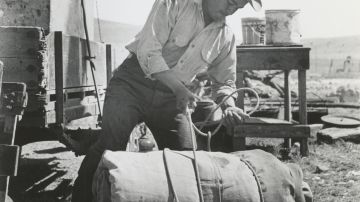14 Discriminatory Practices and Hate Crimes Made Against Latinos in the U.S.
It’s important for us as people to know our history — both the good and the bad

Photo: Unsplash/@nypl
It’s important for us as people to know our history — both the good and the bad. Remember that quote that says if you don’t know your history, you’re doomed to repeat it? It’s true. Time seems to erase some atrocities that happen again and again throughout history, and each time it’s treated by everyone as a new occurrence. It’s time to show that crimes against Latinxs have been happening for what seems like forever in the United States. It’s not something that has cropped up in recent times — these hate crimes have been going on forever.
It’s important to share this information and call out where it stems from so we can be informed, continue to dismantle, resist the whole system, and continue to create change. Knowledge is power, and it’s time to learn as much as we can to change it all for the better.
Here are several instances in which Latinxs were treated horrendously throughout U.S. history.
wp_*posts
Southwest Lynchings, 1848-1928
Texas, along with the rest of the Southwest, was once part of Mexico. In 1848, the Treaty of Guadalupe Hidalgo allowed Mexicans to maintain their land rights and become U.S. citizens. But this didn’t ensure equality or even fair treatment. It is estimated that at least 597 Mexicans were lynched in the Southwest between 1848 and 1928. This is part of the history we are not taught in U.S. history classes.
wp_*posts
California Gold Rush Lynchings, 1848-1860
There were also lynchings of Mexicans during the California Gold Rush. Those who arrived were experienced miners and their success at finding gold made them a target for Americans who felt they and the U.S. in general, were being robbed. At least 163 Mexicans were lynched between 1848 and 1860 in California due to this hatred and fear.
wp_*posts
La Matanza, 1910-1920
https://www.instagram.com/p/BzeQd3AAJ_6/
Within the lynchings in the Southwest between the late 1840s and late 1920s, there was a particular series of murders known as La Matanza. Between 1910, when the Mexican Revolution started, and 1920, Anglo Texans, including the Texas Rangers, lynched hundreds of Mexican Americans, including 20-year-old Antonio Rodriguez.
wp_*posts
Bisbee Deportation, 1917
Mass deportations of Latinxs is not a new thing. Violence and resistance against those who go on strike in order to secure their rights and create change aren’t new either. It is something that we have had to deal with for decades. The Bisbee Deportation (July 11, 1917) saw 1,300 miners (which included Mexicans) who were on strike, along with supporters and bystanders forcibly taken from Arizona and left in New Mexico. There was also deportation of miners from Jerome five days earlier (July 5, 1917).
wp_*posts
Porvenir Massacre, 1918
#tdih 1918 100th anniv., Porvenir Massacre. 15 Mexican-Americans pulled from homes, marched to river, executed by Texas Rangers. School teacher documented names & story. Read: https://t.co/BU8z0WSuWp Follow: @Refusing2Forget pic.twitter.com/4yivlg7bZC
— Zinn Ed Project (@ZinnEdProject) January 29, 2018
The following year, the Porvenir Massacre took place. On January 1918, the Texas Rangers raided Porvenir, a village in Texas, under suspicion that some of its residents were involved in the Brite Ranch Raid. They removed 15 males from their homes and executed them on a nearby hill. The men were between 16 and 50 years old.
wp_*posts
Mexican Repatriation, 1930s
https://www.instagram.com/p/Bo0B4m3gc-y/
Some of the worst things done to Latinxs in the United States have been done to us directly by the U.S. government. Including the Mexican Repatriation. During the Great Depression of the 1930s, the sentiment was that Mexicans were taking jobs from Americans, and should be deported. This led to up to 2 million people being deported to Mexico, with about 60% of them being actual U.S.-born citizens.
wp_*posts
Zoot Suit Riots, 1943
A well-known direct attack on Chicanos (as well as African-Americans and Filipino-Americans), is the Zoot Suit Riots. Taking place in Los Angeles from June 3-8, 1943, it involved American WWII servicemen who attacked youth wearing zoot suits. Fabric was rationed during the war and these suits used a lot of fabric to achieve its particular look. Those in the military saw this “waste” of textiles as unpatriotic, as everything was reserved for the war effort.
wp_*posts
Chicano Soldier Killed in Battle Initially Denied A Dignified Burial, 1945
Chicano Felix Z. Longoria Jr. was considered good enough to serve his country during WWII. But when he died in combat, his wife was blocked from giving him the dignified burial he deserved at home, which was in Three Rivers, Texas. The director of the local funeral home wouldn’t allow for a wake there or for Longoria to be buried in what was considered the white cemetery. Thankfully, Felix Longoria was reinterred in Arlington Cemetery, with full military honors
wp_*posts
Medal of Honor Recipient Denied Service in Hometown, 1945
Another incident involving the disrespect of a Mexican soldier who fought for the United States during war involves Chicano Marcario Garcia. The Staff Sargeant was the first Mexican awarded the Medal of Honor, the highest decoration a soldier can receive. But that didn’t make Garcia immune to discrimination at home. He was denied service at a restaurant outside of Houston for being Latino, beaten with a bat by the owner, and then charged for the incident (before those charges were dropped after an uproar).
wp_*posts
Operation Wetback, 1953-1958
https://www.instagram.com/p/Bz9Sct7FXeN/
Operation Wetback was horrible, starting with its name. The 1954 initiative was created to deport as many Mexicans as possible. As with previous deportations, U.S. citizens were included in the mix and removed from their actual home. 1,074,277 Latinxs were deported in the first year alone.
wp_*posts
Douglas, Arizona Campesino Attack, 1970s
Another event of hatred towards Latinxs that occurred in Arizona is the attack on three Mexican campesinos in Douglas in 1976. While crossing a ranch into the country, they were kidnapped, tortured, and shot as they ran away, after being told to run back to Mexico.
wp_*posts
The Cuban Marielito Stigma in Florida, 1980
The 125,000 Cubans arriving in Florida in 1980, are known as the Marielitos (because they left from Port Mariel). When they made it to the United States, they had to live with the stigma, prejudgment, and discrimination of being lumped in with the criminals and mental institution patients Fidel Castro released and sent to the United States during this time.
wp_*posts
Dolores Huerta Beaten by SFPD Officer, 1988
Even an iconic figure such as Dolores Huerta has seen her share of discrimination and violence. While peacefully protesting in San Francisco, she was brutally attacked by an SFPD officer. The beating was so bad that she had to have emergency surgery to remove her spleen and suffered several broken ribs.

















